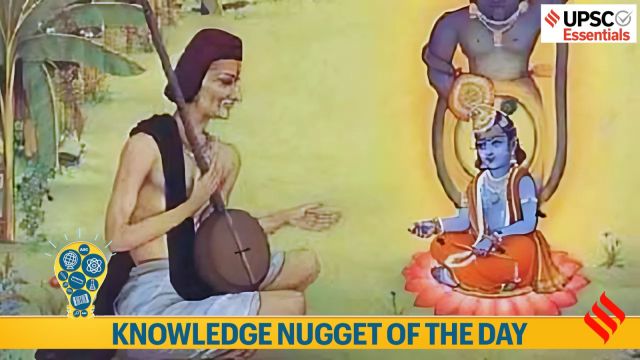
Knowledge nugget of the day: Haveli Sangeet
Take a look at the essential events, concepts, terms, quotes, or phenomena every day and brush up your knowledge. Here’s your knowledge nugget for today.
Haveli Sangeet is a blend of music, spirituality, and history that exemplifies India’s intangible cultural heritage. From the perspective of the UPSC CSE, this topic is significant as it relates to various important themes, such as the impact of the Bhakti Movement, the fusion of religion and art, and the evolution of classical music. All these aspects are crucial for UPSC preparation.
2. This music form declined during the medieval period but saw a revival with the rise of the Bhakti movement, particularly through the Pushtimargiya Sangeet Parampara of the Vaishnav Sampradaya.
3. Haveli Sangeet, although only about five centuries old, preserves the traditions of Bhakti music that have been present in India’s temples for over 5,000 years. The survival of Haveli Sangeet is credited to dedicated practitioners who defended its purity against external influences, ensuring the continuity of this spiritual art form.
Vallabhacharya and Haveli Sangeet
1. In 1556, Vallabhacharya found a divine form of Bhagwat, which he named Lord Shrinath, or the ‘Consort of the Goddess of Wealth,’ in a cave on Giriraj Mountain. Vallabhacharya intended to build a grand temple for this deity but was concerned about its potential destruction during the reign of Aurangzeb. As a result, the deity was moved several times before finally finding a permanent home in Nathdwara, Rajasthan.
2. Vallabhacharya selected four disciples—Kumbhandas, Surdas, Parmanandas, and Krishnadas—for devotional services, and Kumbhandas was appointed the first kirtankar (singer) of Shrinath.
3. Ashta Sakhas: The tradition flourished under Vallabhacharya’s son, Shri Vitthalnath (also known as Shri Gusai). Gusai systematised the sewa (service) and added four more disciples — Govindawami, Chhitaswami, Chaturbhujdas and Nanddas — to the original group, forming the Astachaps or Ashta Sakhas (eight companions) of the Lord. These Astachaps were master composers, blending text and music with exceptional skill.
4. Gusai introduced the concepts of raga (melody), bhog (offering), and shringar (adornment) as integral parts of the sewa. The raag sewa involves singing padas (devotional hymns) in different ragas and taals (rhythmic cycles) according to the eight prahars (time periods) as part of the Ashtayam sewa, including Mangala, Shringar, Gwaal, Rajbhoga, Uthapan, Bhoga, Sandhya, Aarati, and Shayan.
The kings from across the states of India, namely Rajasthan, Gwalior, Agra, Punjab, Gujarat, Madhya Pradesh, Uttar Pradesh and Maharashtra were all followers and disciples of the Vallabh Sampradaya, and thus this traditional music eventually reached their court musicians..
5. Today, the temple of Shrinathji in Nathdwara, known as the Haveli of Shrinathji, serves as the seat of the Pushtimarg. Since the Pushtimarg temples were referred to as Havelis, the music associated with these temples became known as Haveli Sangeet.
Haveli Sangeet- A blend of tradition and devotion
In Bhagwat Purana, there are nine forms of devotional services: hearing (sravanam), chanting (kirtanam), remembering (smaranam), serving (pada-sevanam), worship of the deity (arcanam), praying (vandanam), carrying out orders (dasyam), serving Him as a friend (sakhyam) and sacrificing everything for the Lord (atma-nivedanam). Among these, kirtanam holds a significant place. The Pushti Margiya temples of the Vallabha sect became major centres of Kirtan Bhakti, where Haveli sangeet thrived.
1. Pandit Jasraj was one of the very few Indian classical musicians who was blessed to have performed Haveli Sangeet in most of the temples in India.
2. There is a misconception that Haveli Sangeet is sung only in the Dhrupad style, while Khyal, Kirtana, and Bhajan styles are also common.
????Khyal Gayaki: It emphasises melody (Bhav and Raga Pradhan), where the focus is on the raga rather than the lyrics.
????Dhrupad Gayaki: It is rhythm and word-centric (Taal and Shabd pradhan), with the lyrics given prominence. In Dhrupad singing within the Haveli Sangeet, a performer cannot break a phrase or word during layakari (rhythmic improvisation).
1. Today, we recognize two systems of classical music: Hindustani and Carnatic. Additionally, there are several other traditions such as folk, tribal, etc.
2. Carnatic music is primarily found in the states of Karnataka, Andhra Pradesh, Tamil Nadu, and Kerala. In contrast, the classical music of the rest of India is known as Hindustani Classical Music. Notably, there are areas in Karnataka and Andhra Pradesh where the Hindustani Classical system is also practiced.
3. Carnatic music is characterized by its homogeneity, whereas Hindustani music reflects a more heterogeneous Indian tradition.
(Sources: Rediscovering Haveli Sangeet: A journey through India’s ancient temple music)
For your queries and suggestions write at roshni.yadav@indianexpress.com
Subscribe to our UPSC newsletter and stay updated with the news cues from the past week.
Stay updated with the latest UPSC articles by joining our Telegram channel – Indian Express UPSC Hub, and follow us on Instagram and X.

 Posts
Posts Sign up as a Teacher
Sign up as a Teacher







